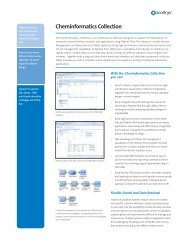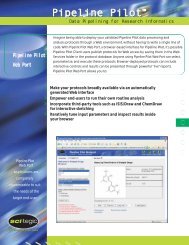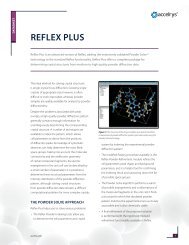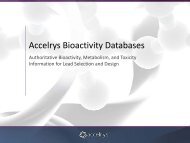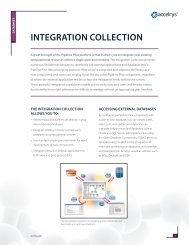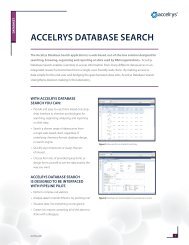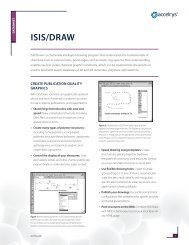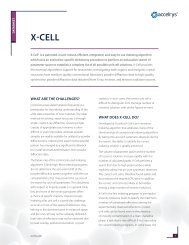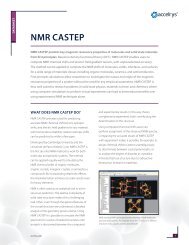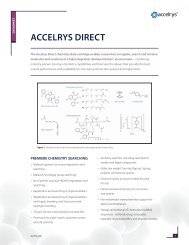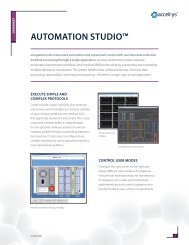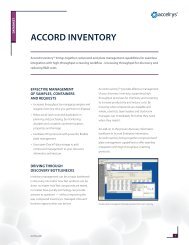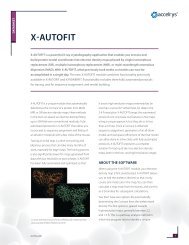Read the ADMET Descriptors in Discovery Studio Datasheet - Accelrys
Read the ADMET Descriptors in Discovery Studio Datasheet - Accelrys
Read the ADMET Descriptors in Discovery Studio Datasheet - Accelrys
Create successful ePaper yourself
Turn your PDF publications into a flip-book with our unique Google optimized e-Paper software.
DATASHEET<br />
aDmeT DescripTors <strong>in</strong><br />
<strong>Discovery</strong> sTuDio<br />
one of <strong>the</strong> most daunt<strong>in</strong>g hurdles a drug candidate must pass is hav<strong>in</strong>g favorable aDmeT<br />
characteristics. <strong>ADMET</strong> refers to <strong>the</strong> absorption, distribution, metabolism, excretion, and toxicity<br />
properties of a molecule with<strong>in</strong> an organism. Optimiz<strong>in</strong>g <strong>the</strong>se properties dur<strong>in</strong>g early drug<br />
discovery is crucial for reduc<strong>in</strong>g <strong>ADMET</strong> problems later <strong>in</strong> <strong>the</strong> development process1 . Such early<br />
identification helps to make your research process more efficient and cost-effective by allow<strong>in</strong>g<br />
you to elim<strong>in</strong>ate compounds with unfavorable <strong>ADMET</strong> characteristics early on, and evaluate<br />
proposed structural ref<strong>in</strong>ements that are designed to improve <strong>ADMET</strong> properties, prior to resource<br />
expenditure on syn<strong>the</strong>sis.<br />
<strong>ADMET</strong> <strong>Descriptors</strong> <strong>in</strong> <strong>Discovery</strong> <strong>Studio</strong>® <strong>in</strong>clude<br />
models for <strong>in</strong>test<strong>in</strong>al absorption, aqueous<br />
solubility, blood bra<strong>in</strong> barrier penetration, plasma<br />
prote<strong>in</strong> b<strong>in</strong>d<strong>in</strong>g, cytochrome P450 2D6 <strong>in</strong>hibition,<br />
and hepatotoxicity. With <strong>the</strong>se advanced<br />
predictive tools, you can optimize your drug<br />
discovery efforts and ga<strong>in</strong> critical <strong>in</strong>sight early on<br />
to avoid expensive reformulation later.<br />
The <strong>Discovery</strong> sTuDio<br />
research environmenT<br />
<strong>ADMET</strong> <strong>Descriptors</strong> are part of <strong>the</strong> <strong>Discovery</strong><br />
<strong>Studio</strong> research environment, which is a<br />
comprehensive suite of model<strong>in</strong>g and simulation<br />
solutions for life science researchers. Because<br />
<strong>Discovery</strong> <strong>Studio</strong> is built on SciTegic Pipel<strong>in</strong>e<br />
Pilot, <strong>Accelrys</strong>’ scientific operat<strong>in</strong>g platform,<br />
<strong>the</strong>se modules are extensively <strong>in</strong>tegrated with<br />
many o<strong>the</strong>r powerful software applications that<br />
will allow you to carry out such tasks as align<strong>in</strong>g<br />
sequences, creat<strong>in</strong>g prote<strong>in</strong> homology models,<br />
build<strong>in</strong>g and analyz<strong>in</strong>g pharmacophore models,<br />
and exam<strong>in</strong><strong>in</strong>g receptor ligand <strong>in</strong>teractions.<br />
accelrys.com<br />
aDmeT DescripTors<br />
<strong>ADMET</strong> <strong>Descriptors</strong> perform computational<br />
prediction based solely on <strong>the</strong> chemical structure<br />
of <strong>the</strong> molecule. Included are six models that<br />
provide a comprehensive analysis of <strong>ADMET</strong><br />
characteristics:<br />
• aDmeT absorption: Predicts Human Intest<strong>in</strong>al<br />
Absorption (HIA) after oral adm<strong>in</strong>istration and<br />
reports a classification of absorption level2 .<br />
The pattern recognition model underly<strong>in</strong>g <strong>the</strong><br />
method is based on calculations of logP, 3 and<br />
polar surface area and is derived from a tra<strong>in</strong><strong>in</strong>g<br />
set of 199 well-absorbed molecules with actively<br />
transported molecules removed.<br />
• aDmeT aqueous solubility: Predicts <strong>the</strong><br />
solubility of each compound <strong>in</strong> water at 25°C<br />
and reports <strong>the</strong> predicted solubility and a<br />
rank<strong>in</strong>g relative to <strong>the</strong> solubilities of a set of<br />
drug molecules. A genetic partial least squares<br />
method was used to derive <strong>the</strong> model based<br />
on a tra<strong>in</strong><strong>in</strong>g set of 784 compounds with<br />
experimentally measured solubilities.<br />
1
• aDmeT Blood Bra<strong>in</strong> Barrier: Predicts <strong>the</strong> blood bra<strong>in</strong><br />
barrier penetration of a molecule, def<strong>in</strong>ed as <strong>the</strong> ratio of <strong>the</strong><br />
concentrations of solute (compound) on <strong>the</strong> both sides of <strong>the</strong><br />
membrane after oral adm<strong>in</strong>istration, and reports <strong>the</strong> predicted<br />
penetration as well as a classification of penetration level.<br />
The model comb<strong>in</strong>es a confidence ellipse derived from over<br />
800 compounds classified as CNS <strong>the</strong>rapeutics, and a robust<br />
regression model based on 120 compounds with measured<br />
penetration, to predict penetration values for those molecules<br />
fall<strong>in</strong>g with<strong>in</strong> <strong>the</strong> confidence ellipse.<br />
• aDmeT plasma prote<strong>in</strong> B<strong>in</strong>d<strong>in</strong>g: Predicts whe<strong>the</strong>r or not a<br />
compound is likely to be highly bound to carrier prote<strong>in</strong>s <strong>in</strong><br />
<strong>the</strong> blood. Predictions are based on <strong>the</strong> similarity between <strong>the</strong><br />
candidate molecule and two sets of marker molecules; one<br />
used to flag b<strong>in</strong>d<strong>in</strong>g at a level of 90 percent or greater and <strong>the</strong><br />
o<strong>the</strong>r at 95 percent or greater. B<strong>in</strong>d<strong>in</strong>g levels predicted by <strong>the</strong><br />
marker similarities are modified accord<strong>in</strong>g to conditions on<br />
calculated logP.<br />
• aDmeT cyp2D6 B<strong>in</strong>d<strong>in</strong>g: Predicts cytochrome P450 2D6<br />
enzyme <strong>in</strong>hibition and reports whe<strong>the</strong>r or not a compound<br />
is likely to be an <strong>in</strong>hibitor, as well as a probability estimate for<br />
<strong>the</strong> prediction. Predictions are based on an ensemble recursive<br />
partition<strong>in</strong>g model of a tra<strong>in</strong><strong>in</strong>g set of 100 compounds with<br />
known CYP2D6 <strong>in</strong>hibitions.<br />
• aDmeT hepatotoxicity: Predicts <strong>the</strong> occurrence of dosedependent<br />
human hepatoxicity. Compounds are classified as<br />
ei<strong>the</strong>r toxic or non-toxic, and a confidence level <strong>in</strong>dicates <strong>the</strong><br />
model’s likely accuracy. Predictions are based on an ensemble<br />
recursive partition<strong>in</strong>g model of 382 tra<strong>in</strong><strong>in</strong>g compounds known<br />
to exhibit liver toxicity or to trigger dose-related elevated<br />
am<strong>in</strong>otransferase levels <strong>in</strong> more than 10 percent of <strong>the</strong><br />
human population.<br />
references:<br />
accelrys.com © 2011 <strong>Accelrys</strong> Software Inc. All brands or product names may be trademarks of <strong>the</strong>ir respective holders.<br />
DATASHEET: DiScovEry STuDio<br />
These <strong>ADMET</strong> <strong>Descriptors</strong> <strong>in</strong> <strong>Discovery</strong> <strong>Studio</strong> can allow you<br />
to ga<strong>in</strong> critical <strong>in</strong>sight to help you make well-<strong>in</strong>formed, smart<br />
decisions dur<strong>in</strong>g drug development. You’ll be able to <strong>in</strong>vest<br />
your time wisely, focus<strong>in</strong>g on compounds with much higher<br />
probabilities for success <strong>in</strong> <strong>ADMET</strong> test<strong>in</strong>g.<br />
To learn more about <strong>Discovery</strong> <strong>Studio</strong>, go to<br />
accelrys.com/discovery-studio<br />
1. Prentis, R.A., Lis, Y., and Walker, S.R., Br. J. Cl<strong>in</strong>. Pharmac., 1988, 25, 387-396.<br />
2. Egan,W. J., Merz, K.M., Jr., and Baldw<strong>in</strong>, J. J., J. Med. Chem., 2000, 43, 3867-3877.<br />
3. Ghose, A. K.,Viswanadhan, V. N., Wendoloski, J. J., J. Phys. Chem., 1998, 102, 3762-3772.<br />
Plot of Polar Surface Area (PSA) vs. LogP for a sample compounds from <strong>the</strong> <strong>the</strong> World Drug<br />
Index (WDI) database show<strong>in</strong>g <strong>the</strong> 95% and 99% confidence limit ellipses correspond<strong>in</strong>g to<br />
<strong>the</strong> Blood Bra<strong>in</strong> Barrier and Intest<strong>in</strong>al Absorption models.<br />
DS-3027-0811<br />
2



